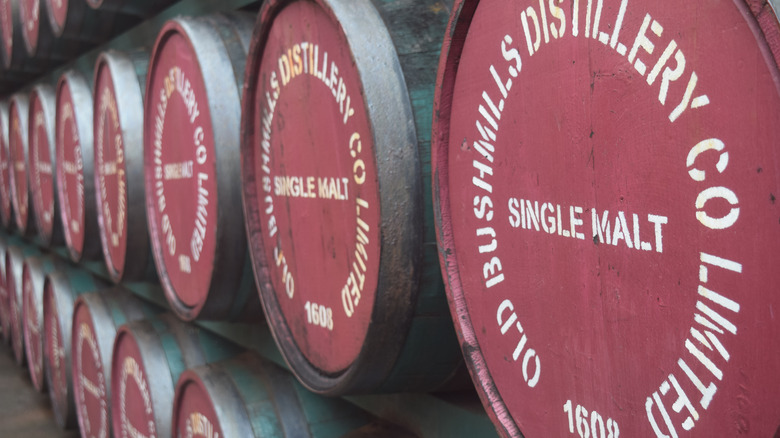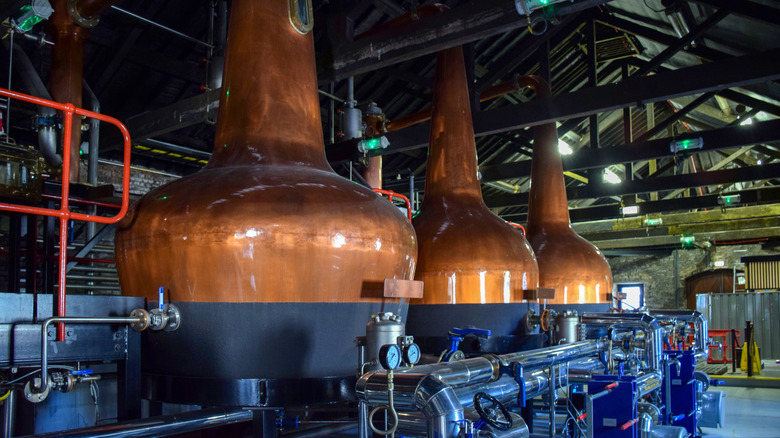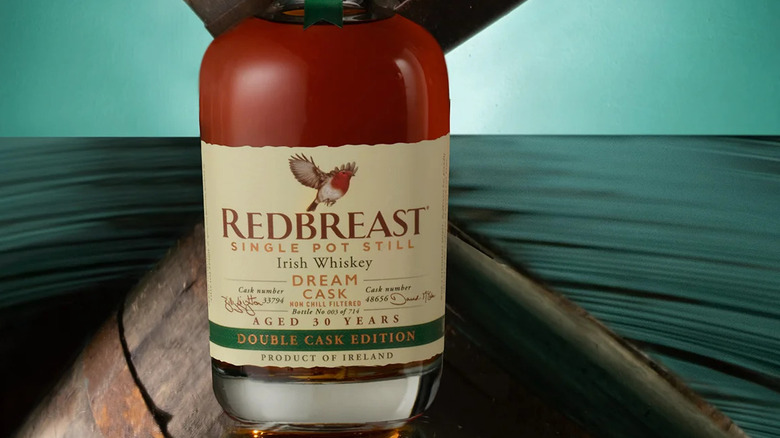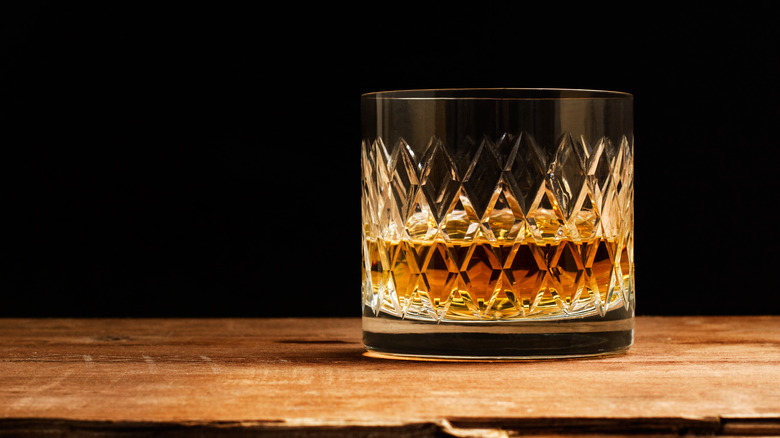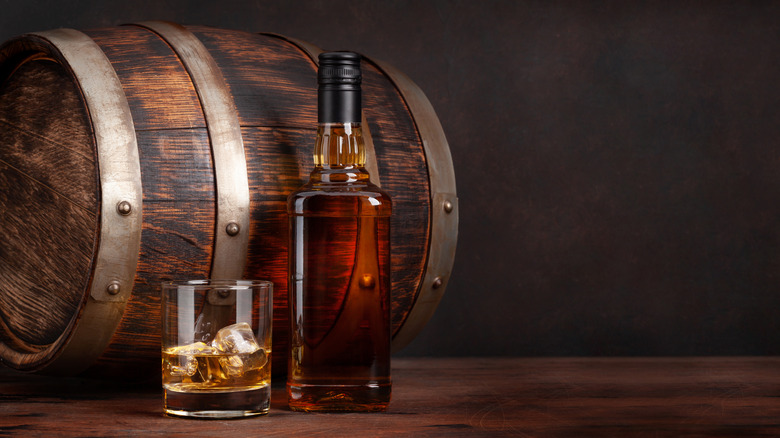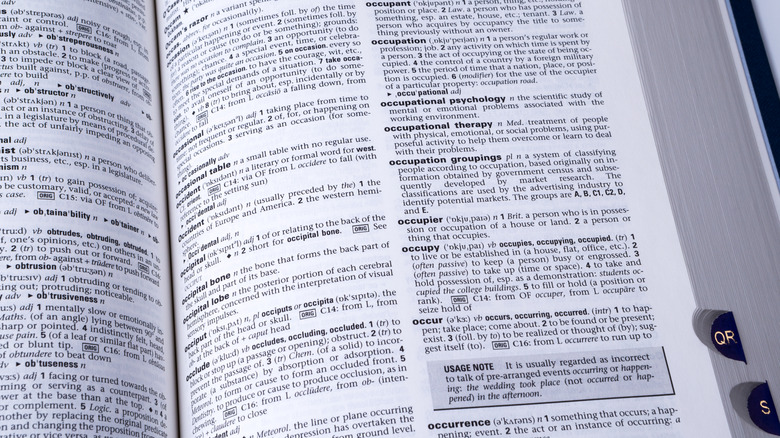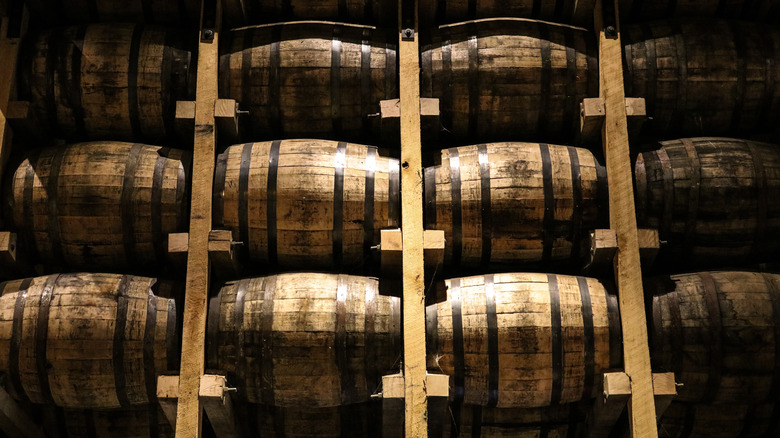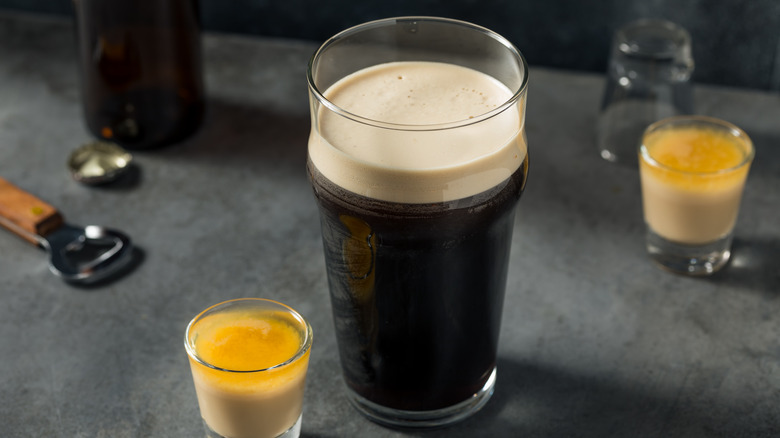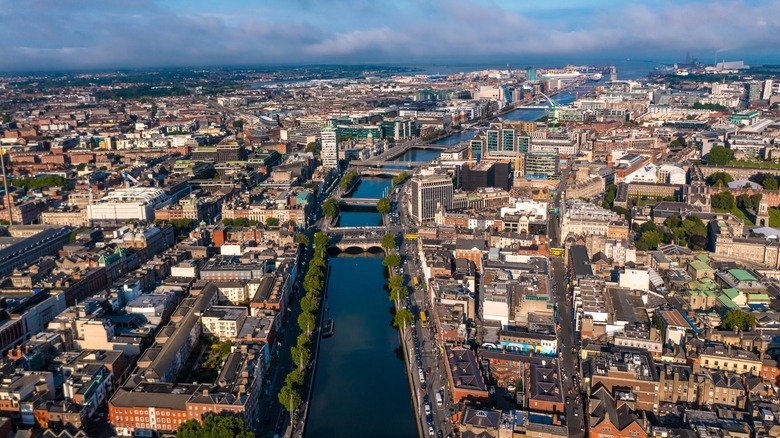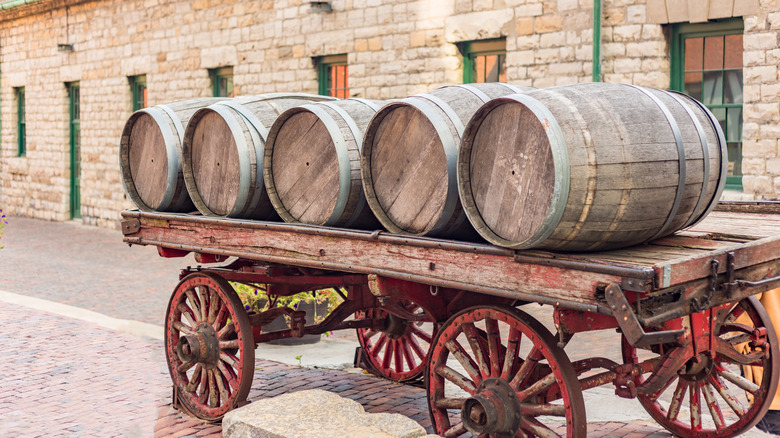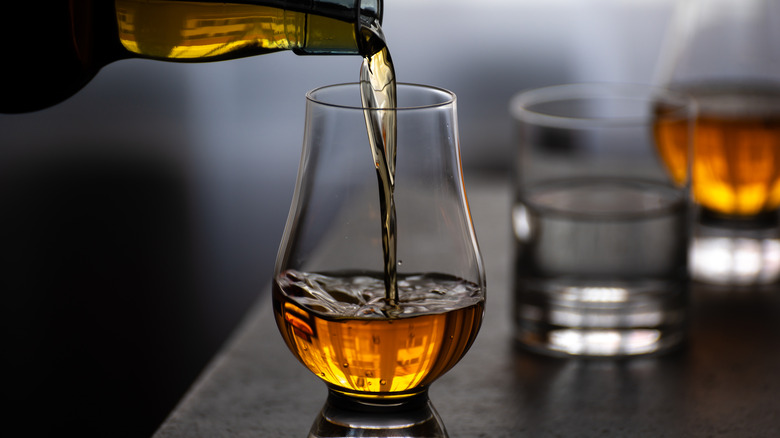Everything You Need To Know About Irish Whiskey
As St. Patrick's day approaches, you might be thinking of digging some green attire out of the wardrobe, heading to a vaguely Irish-sounding bar, popping The Pogues on a jukebox, and ordering a shot of the emerald isle's liquor of choice. While Irish whiskey may not carry as much prestige as its cousin, scotch, it is still one of the most popular shots on the shelf. Jameson, in particular, has regularly been ranked amongst the most popular whiskeys in the world.
But there's more to Irish whiskey than what you see in a shot glass. It's a diverse category of products with its own high-end offerings alongside more affordable blends. It also has a distinct history with a good number of low points, including a disaster that almost destroyed Dublin and a couple of crises that nearly saw the drink go extinct. Let's take a deeper look at what is behind Irish whiskey.
The world's oldest whiskey distillery is Irish
Scotch may feel like a natural way to go if you want a traditional whiskey, but if heritage is your main concern, you need to focus on Ireland. Bushmills, one of the brands you'll see in almost every liquor store, has a unique claim to fame. The Northern Irish distillery was granted its license to distill way back in 1608. This makes Bushmills, which is located in the County Antrim town of the same name, the oldest licensed whiskey distillery on earth. Of course, the origins of the beverage itself stretch back a few hundred years further, but the practice of issuing licenses to distilleries took some time to catch up, and no older distilleries are known to still exist.
This isn't a particularly obscure piece of whiskey trivia. It actually forms the core of many of Bushmills' marketing campaigns. Unfortunately, the fact refers to the company itself and not the actual distillery building. A large fire in 1885 destroyed most of that, and the current distillery was rebuilt on the site. The fire didn't set the company back too far, as Bushmills' whiskey won a gold medal at the 1889 Paris Expo just four years later.
Irish whiskey is traditionally made in a pot still
Like many high-quality spirits, Irish whiskey production tends to rely on the single pot still. There is no standard size for pot stills, and the shapes can vary slightly, but for the most part, they're essentially large copper kettles. If a distillery uses pot stills, it is limited to smaller batches of its product. An alternate type of still, called a Coffey still, was invented in the early 1800s. The Coffey still allows for large batches to be produced at once, but its products tend to lack character — so many whiskey distillers have avoided using them.
The size and shape of a pot still have a lot of bearing on the spirit that still produces, and many distilleries have built their brand around the custom still they use. However, pot stills don't last forever, so don't get your hopes up if you're looking for a distillery that's been using the same apparatus since King James V was on the throne. The distillation process actually removes some copper from the still, and the stills themselves have to be replaced every so often. As the still itself is so important to a whiskey's uniqueness, distilleries tend to go out of their way to have experts build replacements that meet their exact specifications.
Single pot still whiskey is the gold standard
The pot still also lends its name to the pinnacle of Irish whiskey production. At its core, single pot still whiskey is similar to single malt scotch. Both methods involve one distillery producing the product from a single batch of grain. However, there are some key differences. The only grain used to produce a single malt is malted barley, while single pot still whiskeys include a mixture of malted and unmalted barley. Oddly enough, this blend of barleys comes from a 17th-century tax dodging tactic. The English government, which occupied Ireland, levied a tax on malted barley. So Irish distillers swapped some out to save cash. Another key difference lies in the number of times the spirits are distilled. Scotch tends to be double-distilled before it makes its way into a barrel. Aside from a few exceptions, Irish whiskey tends to be triple-distilled before it is left to mature.
As with single malts, single pot still whiskey is a finely crafted, high-end product — so expect to pay a premium. The popularity of scotch has also caused single pot still whiskey to become somewhat of a niche, with many distilleries instead focusing on something more mainstream. It is still possible to get your hands on some, though. If you want to try Ireland's best, consider getting a bottle of Green Spot or Redbreast. As with single malt scotch, you'll be able to tell the difference between single pot still Irish whiskeys and the more mainstream stuff without too much effort.
Irish blends also exist, as do Irish single malts
As with scotch, Irish whiskey can also come as a blend. Like scotch, this is also the type you're most likely to find behind a bar or on a liquor store shelf. Aside from special editions, brands like Jameson, Powers, and Paddy's tend to focus on blended Irish whiskies.
Cheaper Irish whiskies, like the mainstream products from Jameson, Powers, and Paddy's, tend to be blended much like a lot of scotches are. However, these distilleries do sometimes produce single pot whiskies, which are sold as special editions. There is nothing inherently wrong with blends, and many whiskey lovers have certain blends in their collections. Unlike single pot still whiskeys, which contain nothing but malted and unmalted barley, blends can use cheaper products like grain spirit to keep costs down.
To confuse things further, there is another category titled Irish malt whiskey. While a key characteristic of Irish whiskey is its mixture of malted and unmalted barley (at least 30% of each in the mash bill), Irish malt whiskey does away with the unmalted barley altogether. The mash bill for an Irish malt whiskey has to be 100% malted barley.
Some restrictions are similar to scotch, some are different
There is a lot of overlap between scotch and Irish whiskey, however there are some key similarities and differences. Both must be aged in barrels for a minimum of three years, and longer aging periods tend to result in a higher price. With a blend, the age of the youngest whiskey in said blend is the age the whiskey must be marketed as if the blender chooses to label it in that way.
However, mainstream Irish whiskeys tend to be younger. Jameson is aged for a minimum of four years, Powers between five and six, and Tullamore Dew doesn't bother to make that information public — which says a lot. In contrast, many scotch blends like Cutty Sark, Grants, and Johnny Walker Black are aged for a decent period. There are still "no age statement" scotches, like Famous Grouse, but those tend to be closer to the bottom shelf than things like Jameson.
Other differences include the distillation process itself. Scotch can only use natural enzymes during the fermentation process, while Irish whiskey can use added enzymes. It is this rule that actually makes the use of unmalted barley viable. Finally, Irish whiskey is usually triple distilled, while scotch is distilled twice.
It contributed to the American lexicon
One obvious difference between scotch and Irish whiskey boils down to a single letter. Scotch whisky doesn't have an "e" in it. Whisky is actually the older spelling of the two, and it is derived from the Gaelic "uisge beatha" which means water of life. The "e" was added to the spelling later on by Irish distillers who wanted to distinguish their product from the stuff that was being distilled in Scotland.
Despite the popularity of scotch, "whiskey" is the more common spelling in this day and age. This is partially down to the fact there was significantly more Irish immigration to the United States than immigration from Scotland, which ultimately led to the Irish spelling becoming part of the American lexicon. So next time you bother to read the label on a bottle of Jack Daniels and inevitably spot the "e" in the spelling of whisky, you'll know that's down to the shared history between American and the Emerald Isle.
It has another link to the states
The Irish distillation industry may have given Jack Daniels and the U.S. its the spelling of whisky, but Uncle Sam (and Uncle Jack) have given something back in return. Irish whiskey must be aged for a minimum of three years in a cask, and the vessel of choice happens to be an American bourbon barrel.
Before bourbon goes into them, the barrels are made from oak and then charred on the inside. Once they're ready, they're filled with the distilled corn-based liquor and stored for at least two years, but likely many more. The bourbon is then released, and the barrels make their way across the Atlantic, where they'll be used for Irish whiskey. While the barrels are secondhand, Irish distillers aren't buying them to save money. The used casks actually contribute a lot to the Irish whiskey's final flavor. Notes of citrus, vanilla, and caramel from both the oak and the bourbon that soaked into it make their way into the Irish whiskey as it matures. So although it has to be brewed, distilled, and aged in Ireland, there's a little taste of The States in many glasses of Irish whiskey.
It is at the core of many cocktails
While it can certainly be enjoyed neat or with a couple of ice cubes, that isn't the only way to enjoy Irish whisky. Irish whiskey is central to a number of cocktails, some of which are built around the spirit itself, while others are simply complimented by its mildness and unique flavor profile. Both the controversial Irish car bomb and Irish coffee specifically call for the spirit, as you can't call something "Irish" and then use a whiskey with a different national origin. While these two may be considered classics, a new wave of Irish whisky-themed cocktails is emerging thanks to businesses like New York City's Dead Rabbit Irish Cocktail Bar. The bar has even released a book, so fans can easily mix their own "McGlashan" or "Head of Steam" at home.
Irish whisky can also be used as a substitute in a number of classic cocktails. It works particularly well in an old fashioned if the sweetness and strong vanilla flavor of bourbon isn't your thing and you'd prefer something a little milder. Ultimately, it can be used successfully in any whisky-based cocktail. So if all you have on the shelf is a half bottle of Jameson, you still have plenty of options thanks to the versatility of this wonderful spirit.
It almost destroyed Dublin
Unfortunately, the history of Irish whiskey has some dark periods. At one point, it almost destroyed Ireland's capital city, and not for the reasons you may think. On June 18, 1875, a fire at Malone's malt house caused the 5,000 barrels of whiskey it was storing to burst. This led to the spirit flooding through the city's streets, creating a two feet wide, six inches-deep stream of the good stuff. Unfortunately, the 80-proof drink is also quite flammable, so the river of whiskey also carried the fire with it. Damage was done to several buildings, and the fire created havoc amongst the livestock present in the 19th-century city. Thirteen people also died due to the disaster, but their cause of death isn't what you may think.
The deceased wasn't trapped in the flames, nor did they inhale large quantities of smoke. Instead, they were amongst the many people who saw the river of booze and thought it was a fantastic opportunity to get their hands on some free whiskey. People were seen running to the whiskey river with various drinking vessels, while some even cupped their hands and used them to get their share of the precious spirit. Unfortunately, all 13 who perished during the disaster died from alcohol poisoning.
The industry nearly collapsed a century ago
If you look at any liquor store or the shelf behind any bar, you may find it hard to believe that Irish whiskey almost went extinct. But due to a series of catastrophic events in the last century, the industry came very close to collapsing on several occasions. Irish whiskey managed to survive everything the world threw at it during these years but barely clung on — with most of the country's distilleries closing closing between the 1930s and 1970s. The problems really started around 100 years ago.
Ireland had just broken free from Britain and was slapped with a trade embargo as a result. The British Empire was the largest the world had ever seen, and this closed off around a quarter of the globe to an industry heavily reliant on exports. Even worse was the introduction of prohibition in the United States. Irish whiskey made up 60% of whiskey imported to the U.S. during the pre-prohibition era. When the 18th amendment was appealed, and imports started again, whiskey from the emerald isle made up as little as two percent some years.
The success of scotch also hurt the Irish whiskey industry, particularly as Scottish distillers were quick to embrace blends while their Irish counterparts rejected the modern practice. The downturns meant that Ireland only had three distillers left by the time the 1960s came around, and they were forced to merge to survive. But times are rapidly changing.
Despite its struggles, there's never been a better time to get into Irish whiskey
Scotch may be more prevalent on the whole, but Irish whiskey is rapidly catching up. New distilleries are opening their doors, and some more ancient ones, like Ireland's oldest distillery Kilbeggan, have sprung back to life over recent decades. Exports are up year on year, with the spirit's growth in the lucrative U.S. market particularly prominent. It may have a way to go before it overtakes scotch, but Irish whiskey is arguably as strong as it's ever been.
Then you have the cocktail crowd to consider. Neat spirits are not for everyone, and cocktails tend to be on the cutting edge of drinking culture. Irish whiskey is performing well here thanks to businesses like New York City's Dead Rabbit Cocktail Bar. Dead Rabbit has introduced a whole new generation to the spirit and is currently expanding across the United States — bringing its unique take on the traditional liquor with it.
Things are only going to get better for fans of Irish whiskey. The spirit takes years to mature, so while things like single pot stills are currently a rare sight, gallons of the stuff are currently maturing in casks all across Ireland. Who knows, in a few years' time, we may be celebrating St. Patrick's Day with a new favorite tipple.

